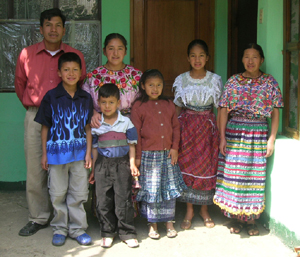K'iche': Difference between revisions
imported>Joe Quick No edit summary |
imported>Joe Quick No edit summary |
||
| Line 9: | Line 9: | ||
The [[Popol Vuh]], sometimes called the "Maya Bible," gives us an insight into the creation of the first K'iche' and relates the foundation of the K'iche' kingdom. The version of the story that is available to us today was written down in the 17th century by several members of the lineages that had ruled the kingdom until their defeat at the hands of [[Pedro de Alvarado]] and his allies. | The [[Popol Vuh]], sometimes called the "Maya Bible," gives us an insight into the creation of the first K'iche' and relates the foundation of the K'iche' kingdom. The version of the story that is available to us today was written down in the 17th century by several members of the lineages that had ruled the kingdom until their defeat at the hands of [[Pedro de Alvarado]] and his allies. | ||
The Popol Vuh tells us that the first four heads of the K'iche' lineages were modeled from corn dough with the ability to see and understand everything instantly: "The moment they turned around and looked around in the sky, on the earth, everything was seen without any obstruction."<ref>Tedlock 1996: 146</ref> | The Popol Vuh tells us that the first four heads of the K'iche' lineages were modeled from corn dough with the ability to see and understand everything instantly: "The moment they turned around and looked around in the sky, on the earth, everything was seen without any obstruction."<ref>Tedlock 1996: 146.</ref> Worried that their creations would "become as great as gods," the creators limited the clarity with which their works saw. Thus were created the first fathers of the K'iche'. Next were created the four women who would be the mothers of the K'iche' people. | ||
The four fathers and four mothers traveled to Tulan Zuyua where they | |||
The K'iche' first made contact with the Spanish conquistadors in 1523, with the arrival of an expeditionary force led by [[Pedro de Alvarado]]. | The K'iche' first made contact with the Spanish conquistadors in 1523, with the arrival of an expeditionary force led by [[Pedro de Alvarado]]. | ||
| Line 28: | Line 30: | ||
Women | Women | ||
==References== | |||
<div class="references-small"> | |||
<references /> | |||
</div> | |||
==Sources== | |||
*Tedlock, Dennis. 1996. Popol Vuh: The Mayan Book of the Dawn of Life. New York: Simon & Schuster. ISBN 0-684-81845-0 | |||
[[Category:Anthropology Workgroup]] | [[Category:Anthropology Workgroup]] | ||
Revision as of 21:38, 18 January 2007
The K'iche' (or Quiché) are one of the largest ethnic groups in Guatemala. They are ethnically Maya and live primarily in the highlands to the north and the west of Lake Atitlán, primarily in the departments of Quetzaltenango, Totonicapan, and El Quiché.
K'iche' also denotes the traditional language of the K'iche' people. This language is still spoken in most K'iche' communities, but many community members also speak Spanish and some do not speak K'iche' at all.
History
Precolonial
The Popol Vuh, sometimes called the "Maya Bible," gives us an insight into the creation of the first K'iche' and relates the foundation of the K'iche' kingdom. The version of the story that is available to us today was written down in the 17th century by several members of the lineages that had ruled the kingdom until their defeat at the hands of Pedro de Alvarado and his allies.
The Popol Vuh tells us that the first four heads of the K'iche' lineages were modeled from corn dough with the ability to see and understand everything instantly: "The moment they turned around and looked around in the sky, on the earth, everything was seen without any obstruction."[1] Worried that their creations would "become as great as gods," the creators limited the clarity with which their works saw. Thus were created the first fathers of the K'iche'. Next were created the four women who would be the mothers of the K'iche' people.
The four fathers and four mothers traveled to Tulan Zuyua where they
The K'iche' first made contact with the Spanish conquistadors in 1523, with the arrival of an expeditionary force led by Pedro de Alvarado.
Colonial
Modern
Religion
Traditional Maya religious custom, or costumbre, is a syncretic conglomeration of pre-Columbian traditions and Catholicism. It combines devotion to the Catholic saints and celebrations of the Catholic festivals with traditional dances and elaborate ceremonies conducted at ceremonial sites that are scattered throughout the surrounding mountains.
Evangelical Protestantism has become increasingly strong since its arrival in the region in the 1970s.
Clothing
As in many Maya groups, clothing carries a lot of meaning for the K'iche'.
Women
References
- ↑ Tedlock 1996: 146.
Sources
- Tedlock, Dennis. 1996. Popol Vuh: The Mayan Book of the Dawn of Life. New York: Simon & Schuster. ISBN 0-684-81845-0
